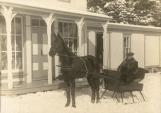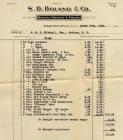14
Vessels mostly brought shipments to the store from suppliers in Halifax who imported goods from elsewhere. However, if a vessel was coming from Newfoundland with a load of fish, it might also have brought seasonal goods such as foxberries. Many people remember getting foxberries from Willie O's store. They were a special treat carried in the fall, and came in barrels of water which kept them fresh for a long time. Although the foxberries are well remembered, invoices for their purchase or shipment have not been discovered yet in the records from the store. It may be that Willie O had a deal with a captain, for trade or barter that he did not record in the store's ledgers.Doris Hutt, in this 2004 interview, remembers running to the store for foxberries:
"And so when he had foxberries, you used to be able to get shortening in a five pound pail. You'd take your pail, over you'd go, and I said before, it was a puncheon, but really wasn't, it was just a barrel. It seemed like a big thing to me at the time. You'd scoop out and pay for your foxberries and away you'd go. Got them from Newfoundland, as far as I can recall. He would get a shipment of them in. Or whether he shared a shipment with somebody else. Or whether the boats came with the…a barrel for you and a barrel for the fellow next down the line. But he'd have more than one. Foxberry pies, foxberry tarts."
16
Willie O used a horse and wagon, or sled as in this photo, to make deliveries. Once the railway opened, he would meet the train in Musquodoboit Harbour with the horse and wagon, and transport goods the seven kilometres back to Oyster Pond.18
The railway was a long time coming to the Eastern Shore of Nova Scotia. Poor funding, ownership changes, and lack of political drive all added to the delays which denied the Eastern Shore communities access to a railroad. The railway was finally opened in 1916, running a passenger and freight service from Halifax to Upper Musquodoboit. The dream to connect Halifax to Guysborough through this railway was never realized. Freight service to Musquodoboit drastically changed the nature of cargo shipping to Oyster Pond. Although Harbour Station was a seven kilometre trip by poor roads, it slowly became the more popular way of shipping goods from Halifax. While the store records continue to show evidence of goods being shipped by schooner, this slowly yields to primarily train transported goods. By the 1930s hardly any vessels show up in the delivery records. (photo courtesy of the Musquodoboit Harbour Railway Museum)From a 2004 interview, Reg Daye recalls the 1930s, when the train was coming in:
"And then the train would bring that from farms, stuff down. Now there at Musquodoboit Harbour, at the railway station, those people…See, there were darn few cars, and they laid their cars up in the fall, probably would run till November. Because it used to snow and the road would freeze and there'd be wagons.
So the first thing the snowstorm would come and they would use riding sleighs, punt sleighs, and wagons, and go and meet the train coming in at Musquodoboit Harbour. I know Christmas time, there was always lots of snow and you could hear the jingle bells go, a long ways a way. And when they got to Salmon River bridge you'd hear their hooves hitting the plank, and they'd be singing, these young people coming home. There be two or three of my sisters and my Howe…"
20
Freight and postage expenses recorded in the ledger books include train freight, postage, trucking by Fulton Bayers, P.W. Judge and Thomas Stoddard, and schooners owned by Alex Jennex and Captain Baker.22
The train became the main freight carrier to the Eastern Shore during the 1920s. However, it was short lived. When the railway was being built, many were against investing money in it instead of improving roads. Eventually the roads improved too. By the 1930s, suppliers were already bypassing the train, and trucking goods directly from Halifax to Oyster Pond. It must still have been an arduous journey.This invoice from S.D. Boland (who was the main grocery supplier to Willie O) shows that the company was shipping by truck and avoiding the train altogether. Freight and postage pages in the ledgers from this time confirm that S.D. Boland & Co. had their own truck and transported goods on behalf of other companies as well.
24
After the Second World War, trucking companies sprang up all along the Eastern Shore. By 1950, trucking was the main means of bringing goods out to Oyster Pond. Mildred and Garth Hosking had deliveries made by these trucking companies, but they also owned a truck that they used for deliveries and for picking up supplies, often on a weekly trip to Halifax.A change in business practices during the early 1950s is apparent in the store records. Where once a company delivered a large order and listed it in one monthly invoice, now the companies issued a packing slip, an invoice, and statement. Packing slips were used because a delivery might only be one or two items. The quantity of paper records from the 1950s is about three times the amount of records generated in the 1940s!
By the 1960s, suppliers had consolidated, so that only a few companies were delivering the majority of supplies needed by the store.




